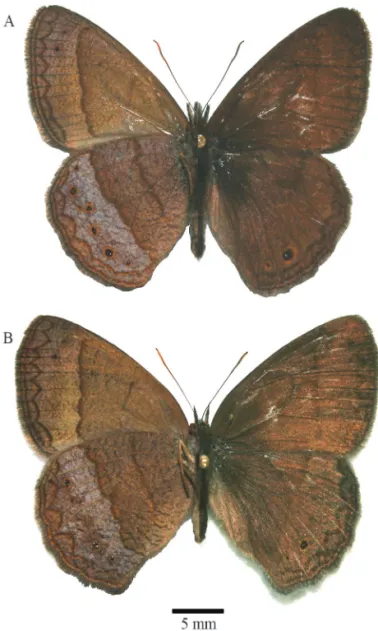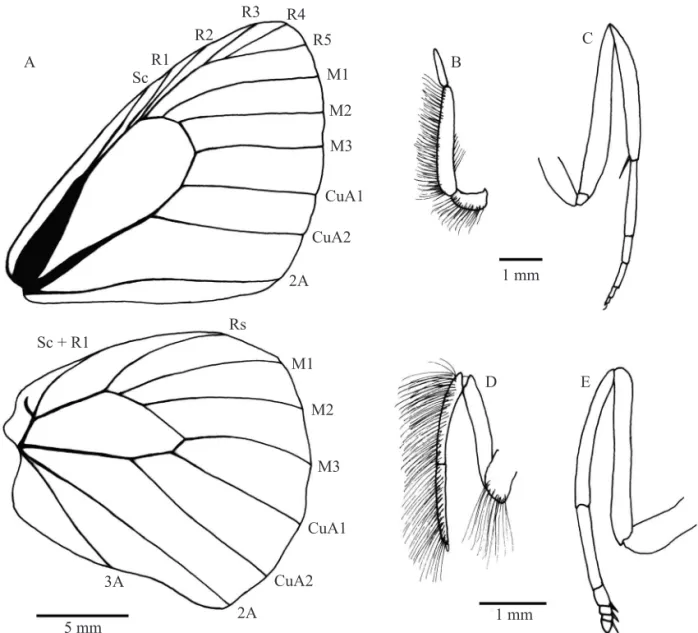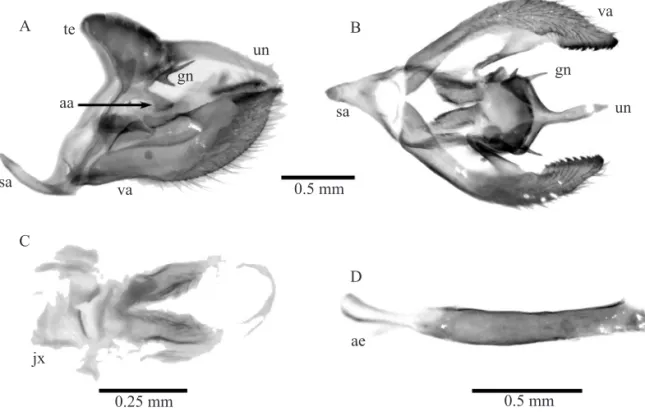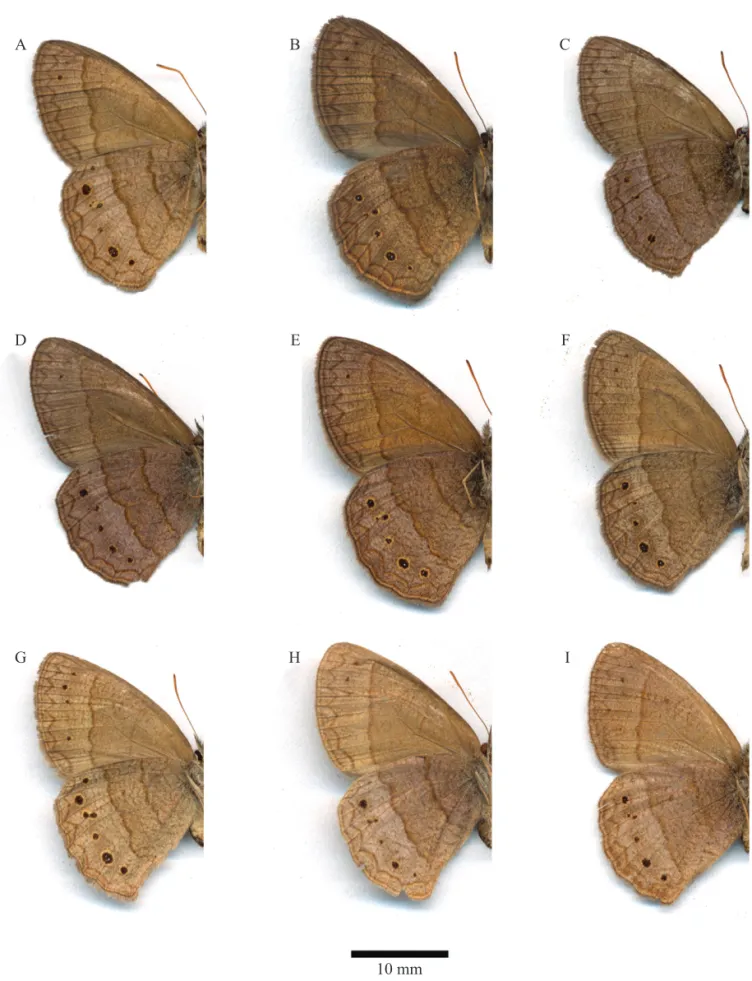SYSTEMATICS, MORPHOLOGY AND PHYSIOLOGY
A New Species of Moneuptychia Forster (Lepidoptera: Satyrinae,
Euptychiina) from the Highlands of Southeastern Brazil
A
NDRÉV.L. F
REITASDepto. Zoologia e Museu de História Natural, Instituto de Biologia, Univ. Estadual de Campinas, C. postal 6109 13083-970, Campinas, SP, baku@unicamp.br
Neotropical Entomology 36(6):919-925 (2007)
Uma Nova Espécie de Moneuptychia Forster (Lepidoptera: Satyrinae: Euptychiina) das Serras Altas do Sudeste do Brasil
RESUMO - Este trabalho descreve uma nova espécie de Moneuptychia Forster das partes altas das serras da Mantiqueira e do Espinhaço, no Sudeste do Brasil, detalha a morfologia de adultos e imaturos desta espécie, e discute a defi nição do gênero Moneuptychia.
PALAVRAS-CHAVE: Borboleta, ciclo de vida, campos de altitude, páramos
ABSTRACT - This paper describes a new species of Moneuptychia Forster from the summits of the Mantiqueira and Espinhaço mountain ranges in southeastern Brazil, details the morphology of adults and immatures of this species, and discusses the defi nition of the genus Moneuptychia.
KEY WORDS: Butterfl y, life history, paramos
The high altitude butterfl y fauna has attracted the attention of naturalists since the earliest voyages throughout the Neotropics. Many studies have discussed the biogeography and ecology of montane species, focusing on patterns of origin, evolution and diversifi cation of this fauna (Willmott et al. 2001, Pyrcz & Wojtusiak 2002, Hall 2005). However, while the majority of these studies concern the Andean region, little is known for the remaining high altitude areas in South America besides species lists (e.g., Zikán & Zikán 1968, but see Viloria & Pyrcz 1994 and Pyrcz & Fratello 2005 for the fauna from the “Tepuys”).
In the highlands of Southeastern Brazil, a series of cool-humid grass-dominated formations, (“Paramos”) occurs scattered along the mountain summits above 1600 -1800 m. These Brazilian Páramos are locally known as “Campos de Altitude”, and little is know about the ecology, biogeography and origins of these systems (Safford 1999). In the last six years, an ongoing project focusing on the diversity of Lepidoptera in São Paulo and neighboring states (see acknowledgments) uncovered about 10 undescribed species of Satyrinae, four of which from the “Campos de Altitude” (Freitas 2004).
The Satyrinae is the most diverse subfamily within the Nymphalidae, including about 2400 species of world-wide distribution (Ackery et al. 1999). Although the Neotropical nymphalids are relatively well known, the subfamily Satyrinae remains poorly understood. Many species await description, many genera and tribes are not monophyletic (Lamas 2004, Freitas 2004, Freitas & Peña 2006), and only recently a preliminary phylogenetic hypothesis for the
subfamily has become available (Peña et al. 2006). One of the last and most comprehensive attempts to organize the Neotropical species in different genera was that by Forster (1964). Forster’s classifi cation was largely followed by Lamas (2004), which is the basis for the present study. However, Forster (1964) did not provide detailed diagnoses, making it diffi cult to assign new species to the genera he erected.
The present study describes a new species of Moneuptychia Forster, 1964 from the highlands of Southern Brazil, including early stages. The validity of this genus as presently defi ned is also discussed based on morphology and molecular evidence.
Study Sites and Methods
The species was studied in the fi eld in three montane sites in SE Brazil: Pico do Itapeva, Pindamonhangaba, São Paulo State (1980-2000 m; 22º45’S, 45º30’W), Parque Estadual de Campos do Jordão, Campos do Jordão, São Paulo State (1600-1800 m; 22º41’S, 45º27’W), and Serra de São Domingos, Poços de Caldas, Minas Gerais (1650-1680 m; 21º46’S, 46º34’W) (all located in the Serra da Mantiqueira range).
Dissections were made using standard techniques. Legs, palpi, and abdomens were soaked in hot 10% KOH solution for 10 min and dissected parts were stored in glycerol. Morphological terms for genitalia largely follow Klots (1956).
several species of bamboos and grasses. Larvae were reared in plastic containers cleaned daily, with fresh plant material provided every two or three days (following Freitas 1991). Data were recorded on behavior and development times for all stages, and dry head capsules and pupal castings were kept in small glass vials. When there was suffi cient material, immatures were fi xed in Kahle solution (Borror & DeLong 1971). All samples from immatures (preserved eggs and larvae, head capsules and pupal castings) are deposited at the Museu de História Natural (Unicamp) (AVLF leg.) All measurements were made using a stereomicroscope fi tted with a calibrated micrometric ocular. Egg size is presented as height and diameter, and head capsule size is the distance between the most external ocelli (as in Freitas 1991).
Moneuptychia itapeva Freitas, New Species
(Figs. 1-5)
Adult: Diagnosis. Eyes naked, entirely brown. Palpus length 2.0 times head height, brown with long brown hairs. Antenna (9-10 mm in length) with 32-34 segments extending to mid-costa; shaft dark brown, dorsally covered by dark brown scales, club with 11-12 segments, not conspicuously developed. Male wing venation shown in Fig. 2A. Forewing relatively short, hindwing outer margin slightly wavy, especially in males. Male foreleg covered by long brown hairs and with two elongated tarsomeres, the fi rst as long as tibia, and the second extremely reduced; female foreleg with fi ve tarsomeres (Fig. 2D,E). The midleg and palpus are shown in Fig. 2B,C.
Male (Figs. 1A, 5A-F). Forewing length 17-20 mm (average 18.6 mm, SD = 0.82, n = 11); hindwing length 14-16 mm (average 14.7 mm, SD = 0.65, n = 11). Body entirely dark brown. Dorsal ground color dark brown with few markings, restricted to marginal and submarginal lines in both wings; hindwing with one or two ocelli in spaces CuA1-CuA2 and CuA2-2A (smaller or absent in some individuals); these are black, surrounded by orange scales, and with white pupil (usually absent in the smaller ocelli). Ventral ground color of wings same as dorsal; forewing crossed by two dark brown lines, the fi rst irregular and obsolescent extending from discal cell to 2A one third from base; the second wavy, extending from costa to 2A at two thirds from the wing base and delimiting a light brown distal area; a dark brown zigzag submarginal line and a brown regular marginal line extending from costa to 2A; two minute black ocelli in spaces R5-M1 and M1-M2 (larger, encircled by orange scales). Hindwing crossed by two dark brown irregular lines from costa to anal margin, the fi rst one-third from the wing base and the second two-thirds from it; second crossing line delimiting a lighter distal area with pinkish tint; a dark brown zigzag submarginal line and a brown regular marginal line extending from costa to 2A; a series of fi ve or six black ocelli outlined by an orange ring, and with white pupil can be found in spaces Rs-M1 (ocellus 1), M1-M2 (2), M2-M3 (3), M3-CuA1 (4), CuA1-CuA2 (5) and CuA2-2A (6); ocellus number 1 usually small and absent in some individuals (Fig. 5E, F); ocellus 3 double (as two partially fused ocelli, usually the distal smaller than the basal) and even triple in a few individuals (Fig. 5A); ocelli 2 and 5
larger than the others, and the 5th always with double white pupil. No conspicuous androconial scales observed.
Male genitalia (Fig. 3). Saccus short and triangular in ventral view; tegumen rounded with a small gnathos shaped as forked lateral structures with two pointed upright processes; appendices angulares extremely conspicuous projecting posteriorly as a long process; uncus elongated and pointed; valvae elongated, ending in a single point, internal margin with a series of small teeth; aedeagus slightly curved upwards; cornuti absent; juxta broad and weakly sclerotized.
Female (Figs. 1B, 5G-I). Forewing length 18-20 mm (average 18.7 mm; SD = 0.79, n = 11); hindwing length 14-16 mm (average 14.8 mm; SD = 0.60, n = 11). Body entirely dark brown. General color and pattern very similar to, but in general paler than that of males and with wings more rounded. Some females also present additional black ocelli in spaces M2-M3 and CuA1-CuA2 in ventral forewing (Fig. 5G).
Remarks on color variation. Variation on the dorsal wing surfaces is small, limited to the number of dorsal ocelli (one or two). The ventral surface of both wings shows some variation in intensity of pigmentation and line shape, and especially in the number and shape of the ocelli (as described above in both sexes) (Fig. 5).
Early stages
Egg. Spherical, yellowish, with 23-25 weakly marked longitudinal ridges and many faint transverse ridges outnumbering the longitudinal. Height 1.00 – 1.14 mm (mean = 1.09 mm, SD = 0.04, n = 8); diameter 1.00 – 1.10 mm (mean = 1.05 mm, SD = 0.04, n = 8). Duration fi ve days (N = 2).
First instar (Fig. 4A, B, J). Head capsule width 0.6 mm; scoli 0.12 mm (n = 1). Head capsule black, with enlarged chalazae, bearing a pair of short scoli on vertex, each with two long narrow setae ending in a fi ne point (Fig. 4J). Third stemmata larger than the other stemmata. Body green, smooth, with red longitudinal stripes; caudal fi laments very short. Setae transparent elongated. Maximum length 5 mm. Duration nine days.
Second instar (Fig. 4C). Head capsule width 0.7 mm; scoli 0.2 mm (n =1). Head dark brown with two diverging short scoli on vertex. Body striped longitudinally with white and reddish; caudal fi laments short. Maximum length 7 mm. Duration 11 days.
Third instar (Fig. 4D). Head capsule width 1.26 mm; scoli 0.26 mm (n = 1). Head brown, with two diverging very short scoli on vertex. Body brown with many longitudinal stripes; caudal fi laments short. Maximum length 12 mm. Duration 14 days.
Fourth instar (Fig. 4E). Head capsule width 1.96 mm; scoli 0.3 mm (n = 1). Very similar to third instar. Maximum length 17 mm. Duration 18 days.
Fifth (last) instar (Fig. 4F). Head capsule width 2.6 mm; scoli 0.56 mm (n =1). Head brown, with two diverging short scoli on vertex. Body brown with many longitudinal stripes; middorsal stripe conspicuously dark; ventral region dark brown; legs and prolegs light brown; caudal fi laments short. Maximum length 23 mm. Duration 22 days. One additional larva reared from the same site underwent 6 instars, but the larva died just before pupation.
Fig. 2. Morphological characters of M. itapeva. A, male wing venation - forewing above and hindwing below; B, male palpus; C, male midleg; D, male foreleg; E, female foreleg.
A
Sc R1
R2
R3 R4
R5
M1
M2
M3
CuA1
CuA2
2A
B
C
1 mm
Sc + R1
Rs
M1
M2
M3
CuA1
CuA2
2A 3A
5 mm 1 mm
Pupa (Fig. 4G-I). Short and smooth; mostly dark brown, with short squared ocular caps; cremaster dark in ventral portion; dorsal abdomen with a paired series of short subdorsal white protuberances bordered with white. Total length 12 mm. Duration 12 days.
Behavior and natural history. Oviposition behavior was not observed in nature, and the host plant in the fi eld is unknown. In the laboratory, larvae easily accepted Bambusa gracilis hort. ex Rivière & C. Rivière (Poaceae), a common ornamental Chinese bamboo. Adults were observed only in open habitats and grasslands, fl ying among grass patches and perching usually on the ground. Males were observed chasing other males on sunny occasions.
Distribution. Besides the three localities mentioned in the methods section, the species was also observed in the Serra do Cipó region including the Serra do Cipó National Park (Serra do Espinhaço mountain range; see details of the region in Freitas 2004), and in the Parque Estadual de Ibitipoca, Lima Duarte (21°41’S, 43°53’W) (in the Serra da Mantiqueira mountain range), both in Minas Gerais, Brazil.
Etymology. The specifi c epithet refers to the Pico do Itapeva, the type locality.
Holotype. Adult male (Fig. 1A) from Pico do Itapeva (22º45’S, 45º30’W), 1980-2000 m, Pindamonhangaba, São Paulo, Brazil, collected by A. V. L. Freitas on December 31, 2005. Deposited in the Museu de Zoologia (MZSP), Universidade de São Paulo, São Paulo, Brazil. Labels on the holotype (three labels, separated by transverse bars):
HOLÓTIPO/B-817 ITAPV 31-XII-2005, Pico do Itapeva - lago, Pindamonhangaba, SP: Brasil, 22º46’S 45º31’W - Alt. ~ 2000m/Holótipo Moneuptychia itapeva Freitas.
Allotype. Adult female, ex-larva (Fig. 1B), same locality as holotype (head capsules and pupal casting deposited in the Museu de História Natural da Unicamp - AVLF leg.), also deposited in the MZSP. Labels on the allotype (three labels, separated by transverse bars): ALÓTIPO/A 311 - Moneuptychia sp., ex larva I-II-2006, Pico do Itapeva – lago, Pindamonhangaba, SP: Brasil, 22º46’S 45º31’W - Alt. ~ 2000m/Alótipo Moneuptychia itapeva Freitas.
Paratypes (Fig. 5B, D). One adult male same locality data as holotype (Fig. 5B); two males, same locality as holotype, collected in January 10, 2006 by the author, all deposited in the Museu de História Natural (Unicamp) (AVLF leg.); one female, Campos do Jordão, São Paulo, B. Pohl leg., no date (MZSP).
Molecular data. DNA sequences COI, EF1α and wingless sequenced (DNA voucher CP12-04, as Yphthimoides sp. in Peña et al. 2006), GenBank accession numbers DQ338815, DQ338962 and DQ338675 respectively.
Additional material. Seven males and 10 females (all from Brazil). São Paulo: Campos do Jordão, Parque Estadual de Campos do Jordão (one female); Pindamonhangaba, Pico do Itapeva (two males, three females); Minas Gerais: Poços de Caldas, Serra de São Domingos, Cristo (one male, fi ve females), Serra do Cipó, Santana do Riacho, Travessão (one male), P. N. Serra do Cipó (three males); Lima Duarte, P. E.
Fig. 3. Male genitalia of M. itapeva. A, lateral view; B, ventral view; C, juxta; D, aedeagus (lateral view); sa = saccus, va = valva, ae = aedeagus, un = uncus, gn = gnathos, te = tegumen, jx = juxta, aa = appendices angulares.
A te
aa
sa va
gn
un
0.5 mm B
sa
va
gn
un
C
jx
0.25 mm
D
ae
Ibitipoca (one female); all deposited in the Museu de História Natural (Unicamp) (AVLF leg.).
Discussion
The genus Moneuptychia was erected by Forster (1964) to include the single species Euptychia soter Butler, 1877, based on the absence of the gnathos (as subunci) in the male genitalia (Forster 1964: 92). However, intrageneric variation in the presence/absence of the gnathos has been reported before in Euptychiina, as for example in Forsterinaria Gray, 1973 (Forster 1964, Peña & Lamas 2005). On the other hand the genitalia of M. soter shows extremely well developed projecting appendices angulares that project posteriorly (Forster 1964: 92), a pattern that was not mentioned by Forster (1964), but possibly an important diagnostic character for Moneuptychia. This character has not been observed in
any other known Euptychiina (Forster 1964, Ebert & Dias 1997, Freitas 2003, 2004, Freitas & Peña 2006, Peña & Lamas 2005, and unpublished results), and might be considered an apomorphic trait for Moneuptychia. Based on this single character, the taxon described was placed in Moneuptychia, even if the gnathos is present in this species.
Recently, Lamas (2004) reorganized Moneuptychia to include four additional species: Euptychia melchiades Butler, 1877 (very much similar to M. itapeva based on wing pattern), and the three species included in the genus Carminda Ebert & Dias, 1998, whose species present a well developed gnathos (Ebert & Dias 1997), but not the conspicuously projecting appendices angulares. In Peña et al. (2006), Moneuptychia, represented by M. itapeva (as Yphthimoides sp.) and Moneuptychia paeon Godart, [1824](= Carminda paeon of Ebert & Dias 1997) appears as polyphyletic, with M. itapeva sister to Euptychoides Forster, 1964, and M. paeon sister to Paryphthymoides Forster, 1964 in two separate clades (Peña
Fig. 4. Immatures of M. itapeva (adult = allotype female, see Fig. 1). A, fi rst instar, dorsal view; B, fi rst instar, lateral view; C, second instar; D, third instar; E, fourth instar; F, fi fth (last) instar (all lateral view); G, pupa lateral view; H, pupa ventral view; I, pupa dorsal view; J, fi rst instar head capsule, frontal view.
A B
C D
E
G H I J
Fig. 5. Adult males (A-F) and females (G-I) of M. itapeva showing variation in underside wing pattern. A, Serra de São Domingos, Poços de Caldas, MG, Feb/1999; B, Pico do Itapeva, Pindamonhangaba, SP; Dec/2005 (Paratype); C, Pico do Itapeva, Pindamonhangaba, SP; Jan/2001 (genitalia illustrated); D, Pico do Itapeva, Pindamonhangaba, SP; Jan/2006 (Paratype); E, Pico do Itapeva, Pindamonhangaba, SP, May/2004 (DNA voucher CP12-04 in Peña et al. 2006); F, Serra do Cipó, MG, May/2002; G, Serra de São Domingos, Poços de Caldas, MG, Feb/1999; H, Parque Estadual de Campos do Jordão, C. do Jordão, SP, Jan/2001; I, Pico do Itapeva, Pindamonhangaba, SP; Mar/2000.
A B C
D E F
G H I
et al. 2006:44). However, since the type species of the genus, Euptychia soter, was not included in their analysis, it is not possible to go further at this time.
Based on the present results, the genus Moneuptychia should be reorganized to contain only three species: M. soter, M. itapeva (both sympatric in SE Brazil) and M. melchiades (known only from Argentina).
It is obvious that much work is needed to determine the validity, limits and specifi c composition of most satyrine genera. It is also important to combine efforts to describe all recognized new taxa, even if it appears diffi cult to assign them to available genera. Additionally, description of early stages of as many species as possible, and comprehensive comparisons within the Euptychiina, could bring important new information to understand relationships within and among some large apparently unnatural groups, such as the genera Yphthimoides Forster, 1964, and Splendeuptychia Forster, 1964 (Murray & Prowell 2005, Freitas & Peña 2006, Peña et al. 2006). With these combined efforts of morphology and with new results from molecular studies, we can hope to have a general overview of the Satyrinae that will improve our understanding of their ecology and evolution.
Acknowledgments
Thanks to Keith S. Brown Jr., Keith Willmott, Marcio Uehara-Prado, Gerardo Lamas, Olaf Mielke, Lee D. Miller, Jacqueline Y. Miller, Carlos Peña, Carla Penz, Niklas Wahlberg, Fernanda Moraes and Ronaldo B. Francini for their help in diverse phases of the manuscript. Marcelo Duarte provided important information about the species from the collection at Museu de Zoologia da USP, SP. Thanks to the Instituto Florestal de São Paulo (Parque Estadual de Campos do Jordão), IBAMA and the direction of the Parque Nacional da Serra do Cipó, for logistic support during fi eld work. This paper was supported by FAPESP grants 00/01484-1 and 04/05269-9 and the BIOTA-FAPESP program (98/05101-8), the Brazilian CNPq (fellowship 300315/2005-8) and the National Science Foundation grant DEB-0527441.
References
Ackery, P.R., R. de Jong & R.I. Vane-Wright. 1999. The butterfl ies: Hedyloidea, Hesperoidea and Papilionoidea, p. 263-300. In N.P. Kristensen (ed.), Lepidoptera: Moths and butterfl ies. 1. Evolution, systematics and biogeography. Handbook of zoology, vol. IV. Walter de Gruyter, Berlin, Part 35, 487p.
Borror, D.J. & D.M. DeLong. 1971. An introduction to the study of insects. Holt, Rinehart and Winston, New York, 812p.
Ebert, H. & M.M. Dias. 1997. Novos gênero e espécie de Satyrinae (Lepidoptera, Nymphalidae) do sudeste brasileiro. Revta. Bras. Zool. 14: 283-298.
Forster, W. 1964. Beiträge zur Kenntnis der Insektenfauna Boliviens XIX. Lepidoptera III. Satyridae. Veröff. Zool. Staatssamml. Münch. 8: 51-188, pls 27-35.
Freitas, A.V.L. 1991. Variação morfológica, ciclo de vida e sistemática de Tegosa claudina (Eschscholtz) (Lepidoptera,
Nymphalidae, Melitaeinae) no estado de São Paulo, Brasil. Rev. Bras. Entomol. 35: 301-306.
Freitas, A.V.L. 2003. Description of a new genus for “Euptychia” peculiaris (Nymphalidae: Satyrinae): Immature stages and systematic position. J. Lepid. Soc. 57: 100-106.
Freitas, A.V.L. 2004. A new species of Yphthimoides (Nymphalidae, Satyrinae) from southeastern Brazil. J. Lepid. Soc. 58: 7-12.
Freitas, A.V.L. & C. Peña. 2006. Description of genus Guaianaza for “Euptychia” pronophila (Lepidoptera: Nymphalidae: Satyrinae) with a description of the immature stages. Zootaxa 1163: 49-59.
Hall, J.P.W. 2005. Montane speciation patterns in Ithomiola butterfl ies (Lepidoptera: Riodinidae): Are they consistently moving up in the world? Proc. R. Soc. B 272: 2457-2466.
Klots, A.B. 1956. Lepidoptera, p. 97-110. In S.L. Tuxen (ed.), Taxonomists’ glossary of genitalia in insects. Munksgaard, Copenhagen, 284p.
Lamas, G. 2004. Checklist: Part 4A. Hesperioidea-Papilionoidea, p.i-xxxvi, 1-439. In J.B. Heppner, (ed.), Atlas of Neotropical Lepidoptera. Vol. 5A. Gainesville, Association for Tropical Lepidoptera/Scientifi c Publishers, xxxvi + 439p.
Murray, D. & D.P. Prowell. 2005. Molecular phylogenetics and evolutionary history of the Neotropical Satyrine Subtribe Euptychiina (Nymphalidae: Satyrinae). Mol. Phyl. Evol. 34: 67-80.
Peña, C. & G. Lamas. 2005. Revision of the butterfly genus Forsterinaria Gray, 1973 (Lepidoptera: Nymphalidae, Satyrinae). Rev. Peru. Biol. 12: 5-48.
Peña, C., N. Wahlberg, E. Weingartner, U. Kodandaramaiah, S. Nylin, A.V.L. Freitas & A.V.Z. Brower. 2006. Higher level phylogeny of Satyrinae butterfl ies (Lepidoptera: Nymphalidae) based on DNA sequence data. Mol. Phyl. Evol. 40: 29-49.
Pyrcz, T.W. & J. Wojtusiak. 2002. The vertical distribution of pronophiline butterfl ies (Nymphalidae, Satyrinae) along an elevational transect in Monte Zerpa (Cordillera de Mérida, Venezuela) with remarks on their diversity and parapatric distribution. Global Ecol. Biogeogr. 11: 211-221.
Safford, H.D. 1999. Brazilian Páramos I. An introduction to the physical environment and vegetation of the campos de altitude. J. Biogeogr. 26: 693-712.
Viloria, A.L. & T. Pyrcz. 1994. A new genus, Protopedaliodes and a new species, Protopedaliodes kukenani from the Pantepui, Venezuela (Lepidoptera, Nymphalidae, Satyrinae). Lambillionea 94: 345-352.
Willmott, K.R., J.P.W. Hall & G. Lamas. 2001. Systematics of Hypanartia (Lepidoptera: Nymphalidae: Nymphalinae), with a test for geographical speciation mechanisms in the Andes. Syst. Entomol. 26: 369-399.
Zikán, J. F. & W. Zikán. 1968. Inseto-fauna do Itatiaia e da Mantiqueira. III. Lepidoptera. Pesq. Agropec. Bras. 3: 45-109.



